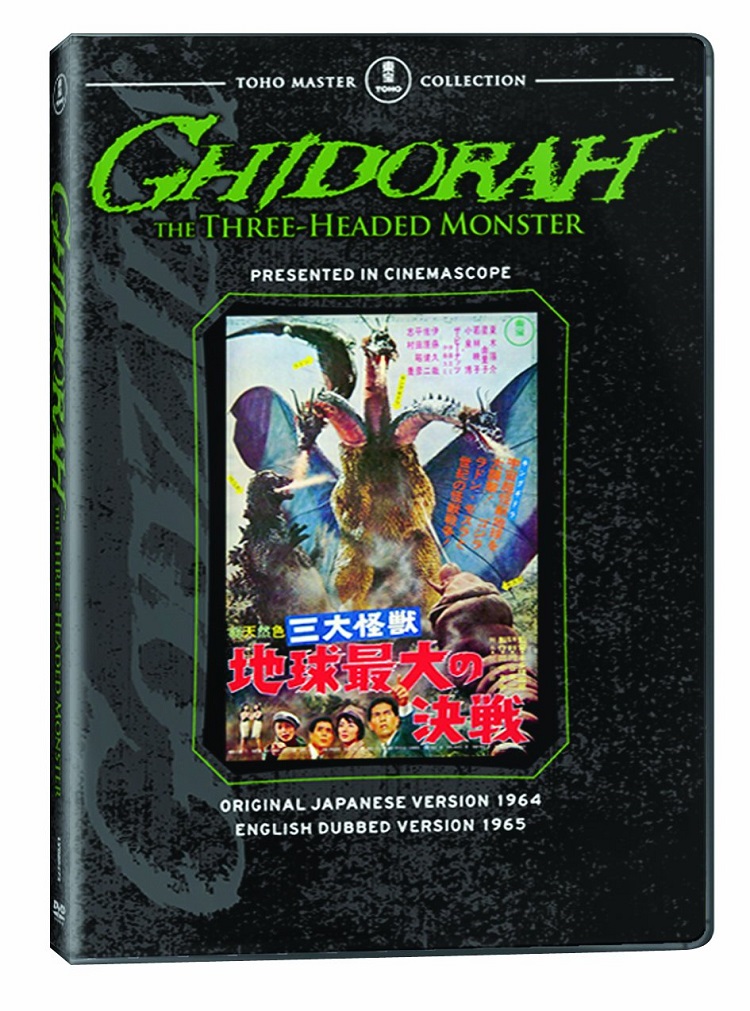
Ghidorah, The Three-Headed Monster was the fifth in the series, premiering in Japan in 1964 and the U.S. in 1965. This was the last Godzilla film that received major edits before crossing the Pacific, eight minutes were cut and scenes were altered. It also forever changed the character of Godzilla who, like many great characters of fiction, turns from villain to hero.
Classic Media released both versions of the film on one DVD, and they each tell the same basic story. A strange gigantic meteor crashes in the wilderness of a Japanese mountain range. During a plane trip to Japan, a disembodied alien saves a princess mid-flight right before her plane is blown up in a coup attempt. When we next see her, dressed like a street urchin, she proclaims to be an alien prophet and foresees the end of the world. When her picture makes the newspapers, her enemies back home wonder if the princess foiled their plans. An assassin is sent to Japan to discover the alien’s true identity.
After an odd television appearance, the twin fairies from Mothra vs Godzilla are set to sail home to Mothra Island. The princess appears warning of more danger, but the captain doesn’t believe her. A female news reporter befriends the princess, meaning she sees an opportunity for an exclusive, and takes her in.
King Ghidorah hatches from the meteor. It is a slight cross between Rodan and Godzilla, but looks like a Chinese dragon. It has large wings and, as the film’s title suggests, three heads, all of which shoot some type of energy/lighting beams. Whenever it is in a scene, there is a great electronic noise on the soundtrack. Left unchecked, Ghidorah will cause the end of the world as it did on the alien’s home world.
As Ghidorah wreaks havoc, Rodan and Godzilla fight out in the countryside. The Mothra fairies are asked to get their master from his island to save the day. Unfortunately, the previous Mothra has died, and the current one is only a caterpillar. However, the fairies think that the combined force of the Earth monsters could defeat Ghidorah. Mothra arrives and breaks up the fight between Godzilla and Rodan, although it could very well be a version of Hackey Boulder they are playing, by shooting his silk on them. They stop and in a very funny scene the monsters talk, which is translated by the fairies. Considering how they have been treated, Godzilla and Rodan see no need to help the humans. Mothra decides to go it alone.
Will the monsters help save Mothra from a certain death? Will Ghidorah destroy mankind? Will the assassins kill the princess? All these questions are answered, and the producers wisely leave open a sequel opportunity.
As long as you can get past the nonsensical script, Ghidorah is a lot of fun. It was a brilliant move of Toho Studios to follow the Universal example of the 1940s and team up their monsters. While the film is admittedly goofy, the effects and miniatures are very well done, even with the occasional appearance of wires. Curiously, Godzilla’s atomic breath looks like smoke in some of the fight scenes. I would have preferred more time of spent on the monsters fighting and causing destruction, and most likely will skip to the fight scenes more often than watching the entire film.
The Classic Media DVD contains a brief biography about special effects legend Eiji Tsuburaya, the original Japanese trailer, and a gallery of movie posters.
Author and film historian David Kalat provides the commentary track on the English version. He talks about both versions, but since there’s not a lot of time needed with plot or themes, he provides a wealth of information about the actors and Japanese film history. Kalat’s sense of humor is poor and he is a little dry at times, but he presents the best argument I have ever heard in support of dubbing. His point to the “subtitles only” supporters is dubbing allows children to enjoy the films, and surely no one can argue the Godzilla films shouldn’t be accessible to children. Presenting the film in both formats should be widely accepted, especially when both versions can easily fit onto one DVD.